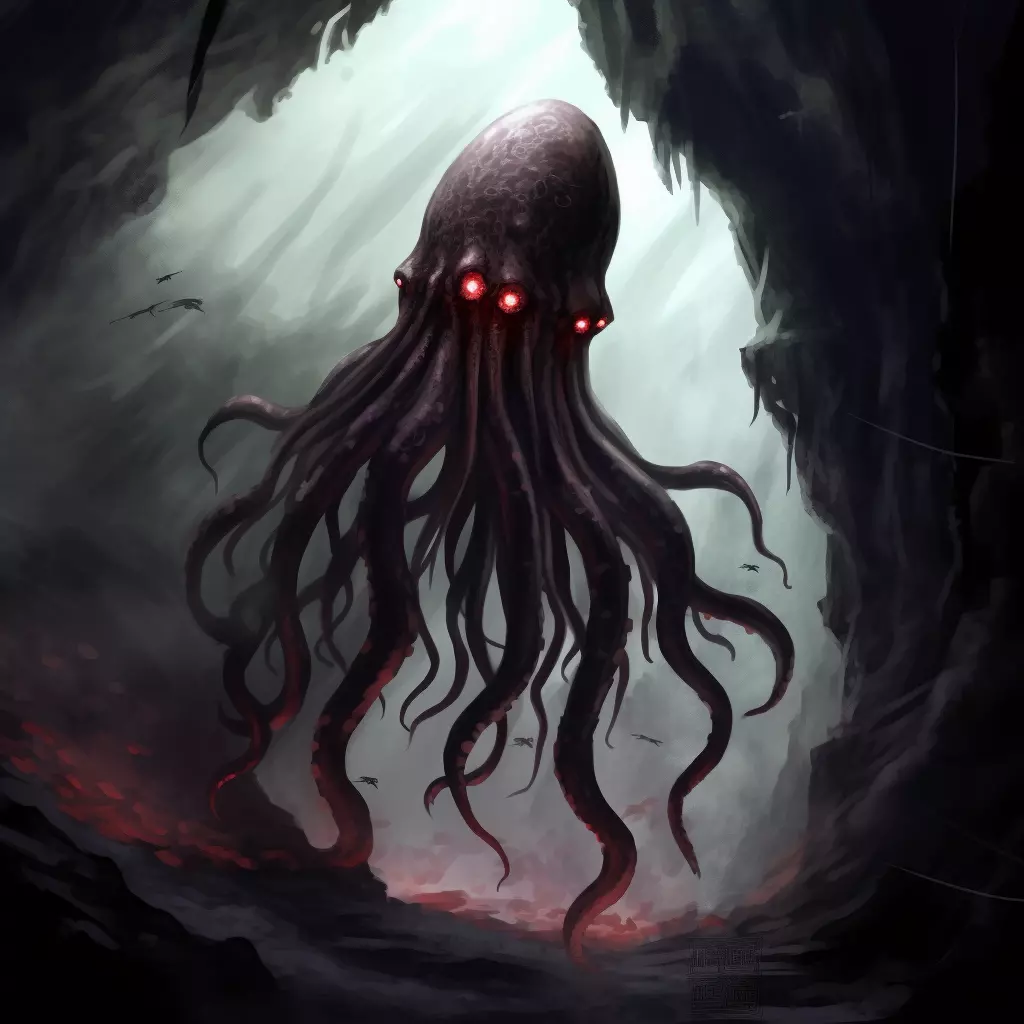Welcome to the A.T.L.A.S. database, your authoritative source for knowledge on extraordinary creatures: this entry delves into the mysteries surrounding the Darkmantle in the DnD 5e universe. Join us as we unveil its basic description, overview its formidable abilities, and assess its threat level.
Basic Description:
The Darkmantle, an otherworldly creature, is a sight to behold. Resembling a large, shadowy cloak suspended from the ceiling, it conceals a terrifying surprise. Its body is adorned with bat-like wings, and many tendrils hang from its underside, giving it an eerie appearance. With a maw lined with sharp teeth, it is a predator lurking in the darkness, ready to strike unsuspecting prey.
Abilities:
The Darkmantle possesses unique abilities that make it a fearsome adversary. It can cloak itself in darkness, blending seamlessly with the shadows and surprising its victims. Utilizing its natural bioluminescence, it emits a mesmerizing, hypnotic glow, rendering its prey disoriented and vulnerable. Its tendrils are used for movement and serve as deadly appendages, constricting and suffocating its targets.
Threat Level Assessment:
The Darkmantle’s threat level is assessed based on its low Challenge Rating (CR) 1/2. Though it may appear less formidable than some creatures, its ability to ambush and incapacitate prey in the darkness should not be underestimated: a single encounter with this monster can be “Easy” for a Standard Party with Level 1, but the encounter becomes “challenging”Hard” with three or more enemies. The Darkmantle is particularly dangerous to those unprepared for its assault. Caution should be exercised in low-light environments where it thrives, and countermeasures should be employed to counter its cloaking abilities.
Darkmantle’s Stat Block
Small monstrosity, unaligned
Armor Class 11
Hit Points 22 (5d6+5)
Speed Walk 10ft. Fly 30ft.
STR 16 (+ 3)
DEX 12 (+ 1)
CON 13 (+ 1)
INT 2 ( -4)
WIS 10 (+ 0)
CHA 5 ( -3)
Saving Throws Str + 3, Dex + 1, Con + 1, Int -4, Wis + 0, Cha -3
Skills Stealth +3,
Senses blindsight 60 ft., passive Perception 10
Challenge 1/2 (100 XP)
Echolocation. The darkmantle can’t use its blindsight while deafened.
False Appearance. While the darkmantle remains motionless, it is indistinguishable from a cave formation such as a stalactite or stalagmite.
Actions
Crush. Melee Weapon Attack: +5 to hit, reach 5 ft., one creature. Hit: 6 (1d6 + 3) bludgeoning damage, and the darkmantle attaches to the target. If the target is Medium or smaller and the darkmantle has advantage on the attack roll, it attaches by engulfing the target’s head, and the target is also blinded and unable to breathe while the darkmantle is attached in this way. While attached to the target, the darkmantle can attack no other creature except the target but has advantage on its attack rolls. The darkmantle’s speed also becomes 0, it can’t benefit from any bonus to its speed, and it moves with the target. A creature can detach the darkmantle by making a successful DC 13 Strength check as an action. On its turn, the darkmantle can detach itself from the target by using 5 feet of movement.
Darkness Aura (1/day). A 15-foot radius of magical darkness extends out from the darkmantle, moves with it, and spreads around corners. The darkness lasts as long as the darkmantle maintains concentration, up to 10 minutes (as if concentrating on a spell). Darkvision can’t penetrate this darkness, and no natural light can illuminate it. If any of the darkness overlaps with an area of light created by a spell of 2nd level or lower, the spell creating the light is dispelled.
Characteristics of Darkmantles:
Darkmantles, often disguised as stalactites, boast limestone-colored skin with a stony dorsal shell. Their distinctive attribute lies in the thick membrane between their tentacles, aiding their navigation and survival in the subterranean depths.
These creatures have vestigial eyes that allow them to perceive variations in light and dark, although they primarily rely on echolocation to navigate their surroundings. With a length of approximately four feet and weighing around 30 pounds, Darkmantles have the extraordinary ability to squeeze through tight spaces due to their lack of bones. Their unique physical attributes make them a true marvel of nature.
Behavior and Preferred Environment:
Darkmantles exhibit limited intelligence and are often found in packs or swarms. Their behavior is influenced by the drow deity Ghaunadaur and the orc deity Shargaas, showcasing their cultural significance within specific communities. These creatures possess various abilities that makes them fit perfectly with their environment: like the capacity to create an aura of darkness and the skill to change their skin color to blend seamlessly with their surroundings. These remarkable attributes enable them to surprise their prey, making them formidable adversaries in the depths below.
Darkmantles are most commonly encountered in the Upperdark and the mysterious Shadowfell, where they find solace in the darkness and enclosed spaces. In settlements like Cloakerhaven, they are kept as peculiar pets, emphasizing their enigmatic nature and potential value to collectors and enthusiasts.
Reproductive Habits and Life Cycle:
Darkmantles possess a hermaphroditic reproductive system, exhibiting both male and female characteristics. They lay their eggs in clutches, demonstrating no parental care once deposited. Darkmantle larvae emerge from these clutches as minuscule grubs and gradually grow into adult Darkmantles with their unique dorsal shells over several months. As these creatures navigate the subterranean realm, they hibernate and require periods of sleep to maintain their vitality.
Cultural Significance:
Darkmantles hold cultural significance among various communities and are associated with specific deities. The drow deity Ghaunadaur and the orc deity Shargaas have expressed favor towards these creatures, highlighting their relevance within these respective pantheons. Furthermore, Darkmantles have been known to serve as peculiar pets to groups such as the shadar-kai, showcasing the intricate interplay between these beings and humanoid societies.
Challenges and Adaptations:
Surviving in the depths of the Upperdark and the enigmatic Shadowfell poses numerous challenges for Darkmantles. Predators dwelling within these realms view Darkmantles as potential prey, prompting them to develop unique adaptations. Their ability to camouflage themselves and take flight provides them the means to evade detection and escape dangerous encounters. These remarkable adaptations and their natural intelligence contribute to their survival in the harsh subterranean environment.
Theories and Origins:
Speculation regarding the origins of Darkmantles continues to captivate the minds of A.T.L.A.S. researchers. One prominent theory suggests a connection between Darkmantles and the enigmatic Shadowfell, proposing that these creatures may have emerged from that mysterious realm.
Another intriguing hypothesis speculates that Darkmantles could have evolved from a related creature known as the piercer, drawing similarities in their physical attributes and subterranean nature. As A.T.L.A.S. tirelessly pursues knowledge, these theories catalyze further exploration and scientific inquiry.
Confrontation a Darkmantle:
When engaging a Darkmantle in combat, extreme caution is advised. These creatures employ a unique tactic of dropping down from cave ceilings, aiming to engulf the heads of their unsuspecting prey. By manipulating their magical darkness, they blind and suffocate their victims, rendering them vulnerable to the sharp, toothed tentacles that deliver devastating slashes. To successfully confront a Darkmantle, it is crucial to employ strategies that neutralize their advantageous position and exploit their vulnerabilities. For instance, utilizing light sources to counteract their magical darkness can provide a significant advantage. Additionally, employing ranged attacks and maintaining spatial awareness will aid in countering their aerial assaults.
As with many subterranean creatures, Darkmantles are part of an intricate ecosystem, facing predation from other cave-dwelling creatures. Their survival instincts have evolved to include camouflage and flight, allowing them to evade potential threats and ensuring their continued existence.
Theories surrounding the origins of Darkmantles propose a connection to the Shadowfell or a possible evolutionary link to a related creature known as the piercer. These hypotheses continue to intrigue researchers within A.T.L.A.S., driving further exploration and investigation into these captivating beings.
Darkmantles, the enigmatic subterranean creatures, have piqued the curiosity of A.T.L.A.S., the esteemed organization dedicated to studying and preserving fantastical beings. In this comprehensive database entry, we shall further explore the intricacies of Darkmantles, including their cultural significance, reproductive habits, and the challenges they face in their natural habitat.
Conclusion
In conclusion, Darkmantles are captivating denizens of the underground world, with a high adaptability to their environment and cultural significance. The mysteries surrounding their reproductive habits, cultural associations, and origins continue to fuel the research endeavors of A.T.L.A.S. As adventurers and scholars venture into the depths, encountering these fascinating beings will unlock a greater understanding of the wondrous tapestry woven by the realms of Dungeons and Dragons.
Credits
Darkmantle is a DnD 5e Creature from the Monster Manual
 Skip to main content
Skip to main content

